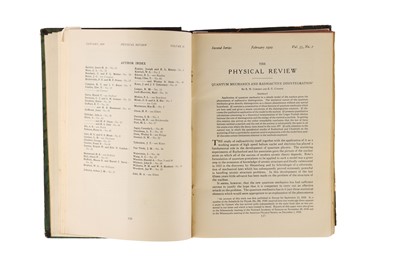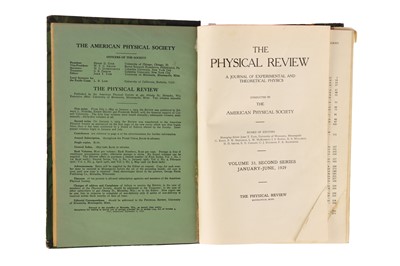24th May, 2023 12:00
Fine Instruments of Science, Medicine and Books
Philip McCord Morse , period Journals
1 - The Physical Review, A Journal of Experimental and Theoretical Physics Conducted by the American Physical Society, Volume 33, Second Series, Number 1, January 1929, faux leather spine with gilt text, green marbled boards, Philip M. Morse and E. G C. Stueckelberg's paper: Diatomic Molecules According to The Wave of Mechanics I: Electronic Levels of the Hydrogen Molecular Ion [p.932 - p.947]
2 - The Physical Review, A Journal of Experimental and Theoretical Physics Conducted by the American Physical Society, Volume 34, Second Series, Number 1, July 1929, faux leather spine with gilt text, green marbled boards, Philip M. Morse's paper: Diatomic Molecules According to The Wave of Mechanics II: Vibration Levels [p.57 - p.64]
The purpose of this article is to more accurately describe the motions of nuclei within a diatomic molecule, using a new approach. The article claims that the previous approach using the QHO (quantum harmonic oscillator) did not sufficiently take account of all the variables affecting the molecules. Instead the author puts forth that the new method, the Morse potential, more fully accounts for these variables and can be applied in a greater variety of models. By today’s standards the Morse potential is outdated, as it is too simplistic for modern spectroscopy. However, the theoretical work presented in this paper enabled the achievements in the field that we see today.
Philip McCord Morse was an American physicist and educator who made significant contributions to the field of nuclear physics. Born on August 6, 1903, in Shreveport, Louisiana, Morse studied at the Massachusetts Institute of Technology (MIT), where he later became a professor.
Morse's research focused on the structure of atomic nuclei and the properties of subatomic particles. He played a key role in the development of the cyclotron, a type of particle accelerator that uses magnetic fields to accelerate charged particles to high speeds.
Morse also made important contributions to the field of nuclear engineering, and he was involved in the development of nuclear reactors for both military and civilian use. He was a co-founder of the Bulletin of the Atomic Scientists and was active in promoting nuclear disarmament and international cooperation in the field of nuclear technology.
The article described above was one of Morse’s first pieces of academic work, published in 1929 when he was 26. During the course of his career, as well as research papers, Morse published eight books.
Philip McCord Morse died on October 31, 1985, at the age of 82. His contributions to the field of nuclear physics and his advocacy for the responsible use of nuclear technology continue to inspire and influence scientists and policymakers today.
1 - The Physical Review, A Journal of Experimental and Theoretical Physics Conducted by the American Physical Society, Volume 33, Second Series, Number 1, January 1929, faux leather spine with gilt text, green marbled boards, Philip M. Morse and E. G C. Stueckelberg's paper: Diatomic Molecules According to The Wave of Mechanics I: Electronic Levels of the Hydrogen Molecular Ion [p.932 - p.947]
2 - The Physical Review, A Journal of Experimental and Theoretical Physics Conducted by the American Physical Society, Volume 34, Second Series, Number 1, July 1929, faux leather spine with gilt text, green marbled boards, Philip M. Morse's paper: Diatomic Molecules According to The Wave of Mechanics II: Vibration Levels [p.57 - p.64]
The purpose of this article is to more accurately describe the motions of nuclei within a diatomic molecule, using a new approach. The article claims that the previous approach using the QHO (quantum harmonic oscillator) did not sufficiently take account of all the variables affecting the molecules. Instead the author puts forth that the new method, the Morse potential, more fully accounts for these variables and can be applied in a greater variety of models. By today’s standards the Morse potential is outdated, as it is too simplistic for modern spectroscopy. However, the theoretical work presented in this paper enabled the achievements in the field that we see today.
Philip McCord Morse was an American physicist and educator who made significant contributions to the field of nuclear physics. Born on August 6, 1903, in Shreveport, Louisiana, Morse studied at the Massachusetts Institute of Technology (MIT), where he later became a professor.
Morse's research focused on the structure of atomic nuclei and the properties of subatomic particles. He played a key role in the development of the cyclotron, a type of particle accelerator that uses magnetic fields to accelerate charged particles to high speeds.
Morse also made important contributions to the field of nuclear engineering, and he was involved in the development of nuclear reactors for both military and civilian use. He was a co-founder of the Bulletin of the Atomic Scientists and was active in promoting nuclear disarmament and international cooperation in the field of nuclear technology.
The article described above was one of Morse’s first pieces of academic work, published in 1929 when he was 26. During the course of his career, as well as research papers, Morse published eight books.
Philip McCord Morse died on October 31, 1985, at the age of 82. His contributions to the field of nuclear physics and his advocacy for the responsible use of nuclear technology continue to inspire and influence scientists and policymakers today.






